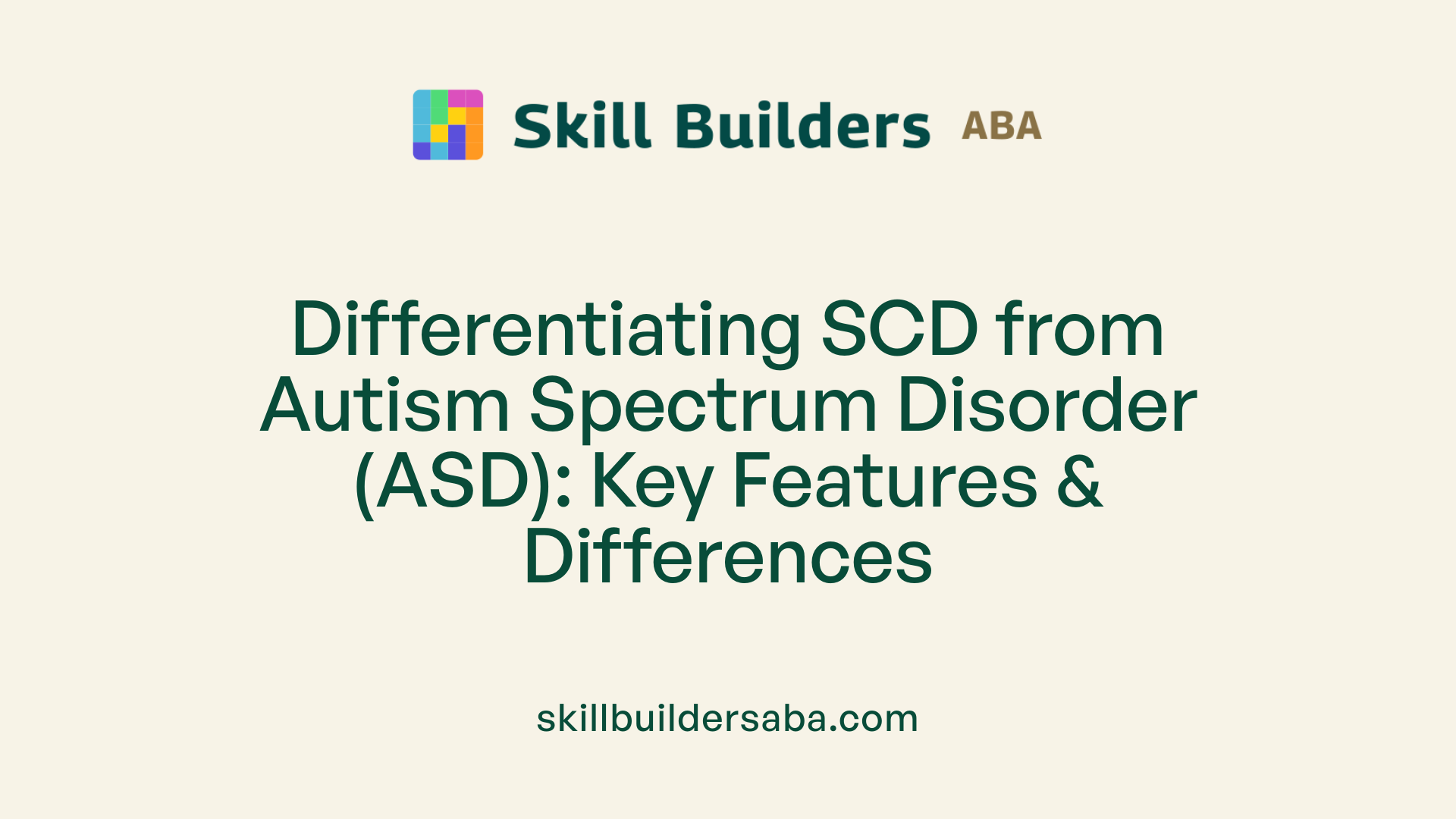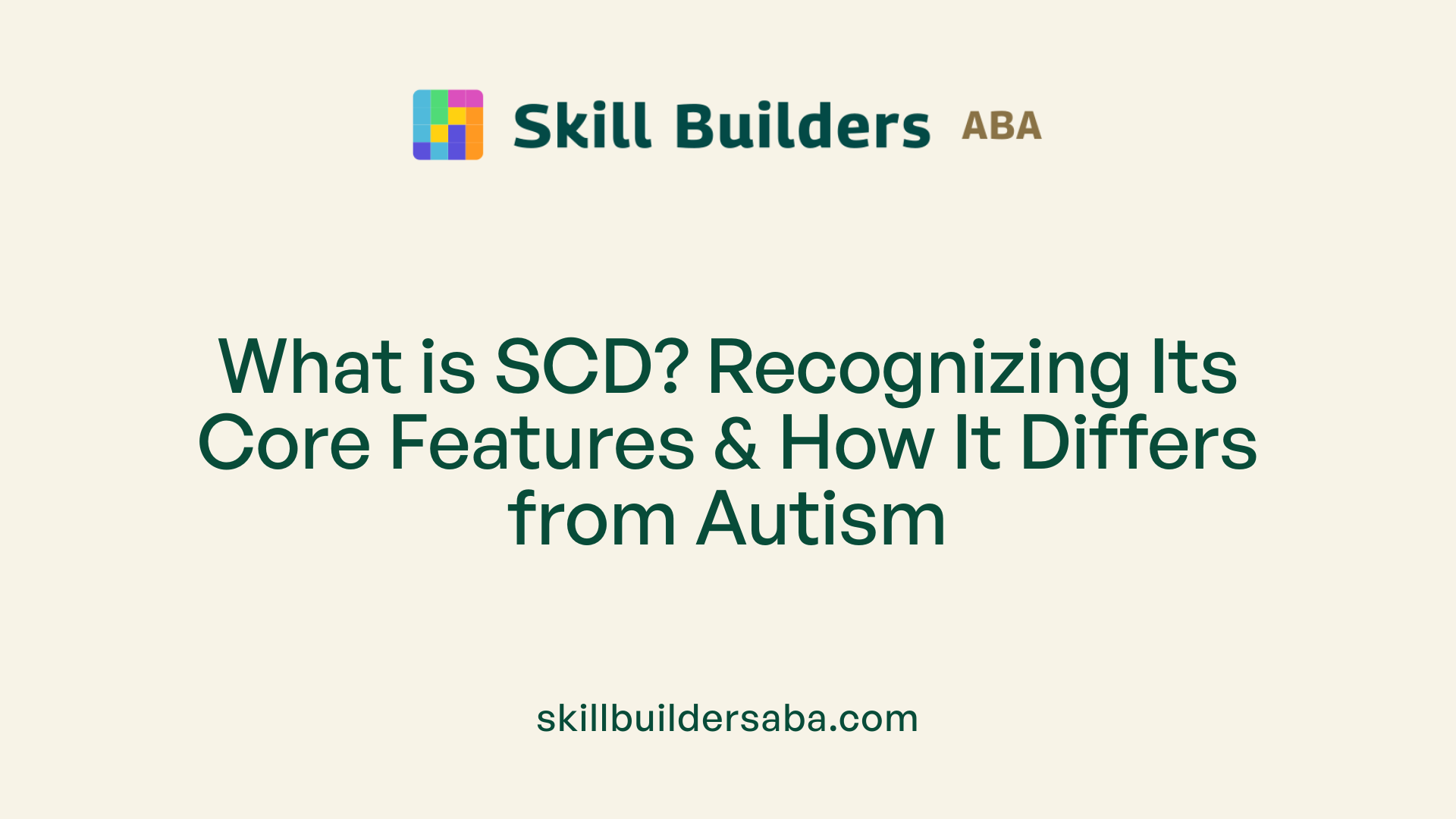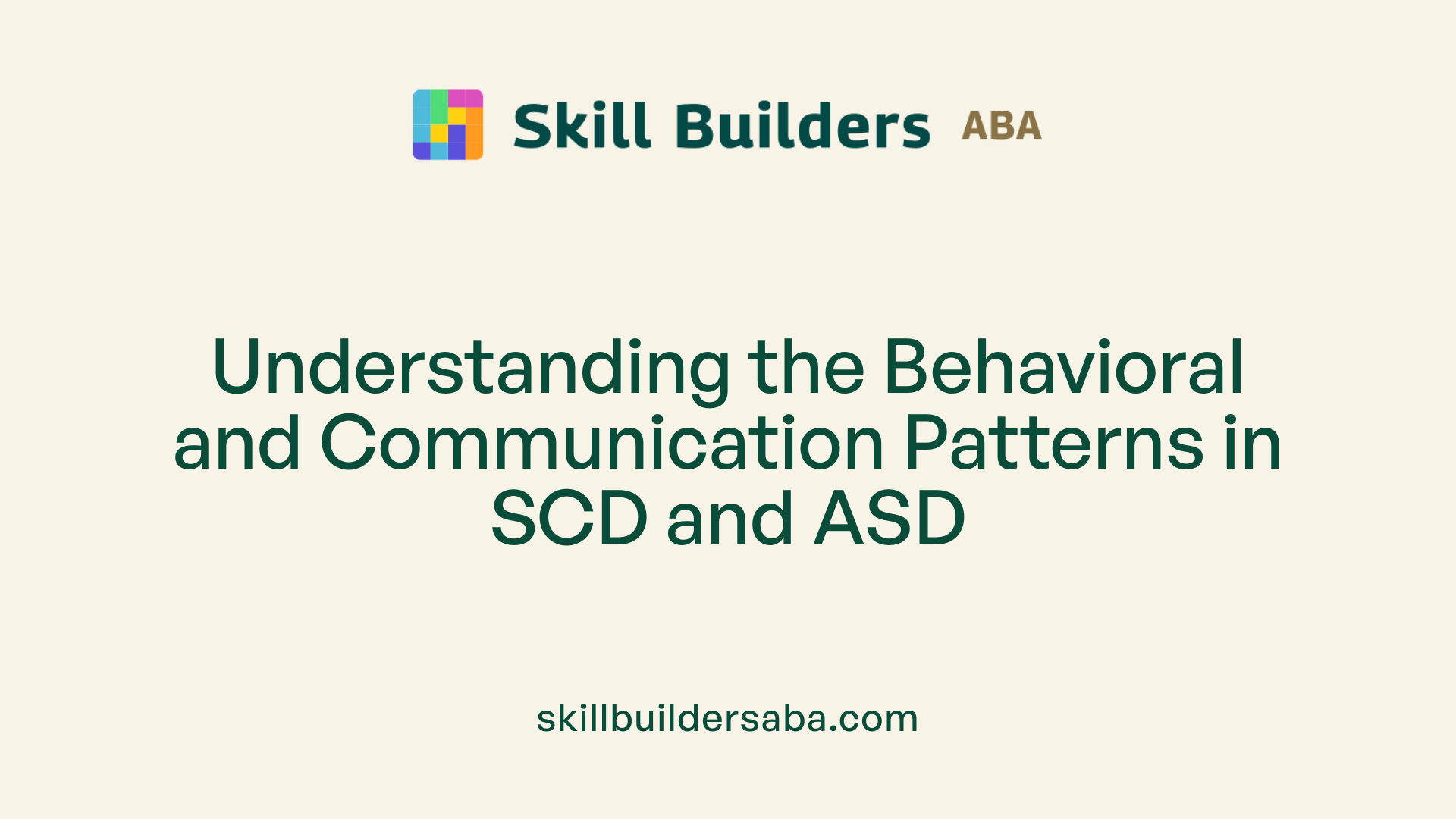Social Communication Disorder vs. Autism
Understanding the Nuances Between Social Communication Disorder and Autism Spectrum Disorder

Deciphering Distinctions in Social and Communication Challenges
While both Social Communication Disorder (SCD) and Autism Spectrum Disorder (ASD) involve difficulties with social communication, they are distinct diagnoses with specific criteria and features. Recognizing these differences is essential for accurate diagnosis, intervention, and support. This article explores the diagnostic criteria, symptoms, assessment strategies, key distinctions, and treatment options for SCD and ASD, highlighting their unique characteristics and overlaps.
Introduction to Social Communication Disorder and Autism Spectrum Disorder

What is the difference between SCD and ASD?
Social Communication Disorder (SCD) and Autism Spectrum Disorder (ASD) are both neurodevelopmental conditions that affect how individuals communicate and interact socially. However, they differ significantly in their core features. SCD primarily involves difficulties with the pragmatic use of language—such as following conversational rules, understanding nonliteral language, and using gestures appropriately—without exhibiting the repetitive behaviors and restricted interests characteristic of autism. ASD, on the other hand, includes these social communication challenges alongside repetitive movements, obsession with routines, sensory sensitivities, and intense focus on specific interests.
Historical context: When was SCD recognized?
SCD was first formally recognized as a distinct diagnosis in the Diagnostic and Statistical Manual of Mental Disorders (DSM-5) in 2013. This inclusion was a major step in differentiating social communication difficulties that are not caused by or linked to autism. Prior to this, many children with pragmatic language issues were often diagnosed with other language disorders or ASD, especially if they showed some overlapping behaviors.
What are the main characteristics of each disorder?
| Feature | Social Communication Disorder (SCD) | Autism Spectrum Disorder (ASD) |
|---|---|---|
| Communication Skills | Difficulties with pragmatic language, including turn-taking, interpreting social cues, and maintaining conversations. | Similar social communication difficulties but often combined with language delays or unusual speech patterns. |
| Repetitive Behaviors | Not present. | Present, including hand-flapping, rocking, spinning, and lining up objects. |
| Sensory Sensitivities | Usually not part of the diagnosis. | Common, with hypersensitivity or hyposensitivity to sensory stimuli. |
| Routines and Interests | No specific interest in routines or sameness. | Preoccupation with routines, highly fixated interests. |
| Onset and Developmental History | Usually develops after initial language milestone delays or pragmatic issues. | Early signs often visible from toddler years, with marked delays and atypical behaviors evident before age 3. |
Can social communication disorder (SCD) occur without autism spectrum disorder (ASD)?
Yes, SCD can occur independently of ASD. Children with SCD demonstrate persistent challenges in social language skills—such as conversation, understanding social cues, and appropriate communication—without exhibiting the restricted or repetitive behaviors seen in autism. Proper assessment by trained professionals ensures accurate diagnosis, differentiating between these conditions to facilitate appropriate intervention.
What are the diagnostic criteria for SCD and autism?
The diagnosis of SCD entails evidence of persistent impairments in social use of language, including difficulties in greeting, engaging in conversations, interpreting non-verbal cues, and adapting language to various social contexts. These issues must significantly impact social, academic, or occupational functioning, and not be attributable to other developmental or medical conditions. In contrast, ASD diagnosis requires the presence of social communication deficits along with restricted interests and repetitive behaviors. Clinicians use observation, standardized tests, developmental history, and questionnaires to assess these criteria, ensuring a clear distinction between the conditions.
What are the common symptoms of social communication disorder?
Features include difficulty initiating or responding appropriately in conversations, trouble understanding non-verbal cues like facial expressions or gestures, challenges with taking turns, maintaining topic coherence, and understanding sarcasm or idiomatic expressions. Children may also have trouble expressing feelings, interpreting others’ thoughts, or adapting communication to different social contexts. These symptoms often hinder forming and maintaining peer relationships, affecting social life and academic success.
How can one differentiate between social communication disorder and autism in assessment?
Assessment involves detailed observation, standardized testing, and developmental history, focusing notably on the presence or absence of restricted and repetitive behaviors. Children with autism demonstrate these behaviors, such as hand-flapping or insistence on routines, while children with SCD typically do not. Speech-language pathologists analyze pragmatic language skills and social reciprocity, alongside behavioral evaluations, to determine whether the core difficulty lies solely in social pragmatics or is part of a broader autism spectrum profile.
What are the differences between SCD and ASD?
The primary distinction is the presence of RRBs and sensory sensitivities in ASD. While both involve social communication impairments, ASD's hallmark features include behaviors like lining up toys, fixated interests, and sensory issues, which are absent in SCD. Furthermore, individuals with SCD generally have normal intelligence levels and no unusual repetitive behaviors, simplifying the diagnosis and focusing interventions more on language and social skills rather than managing stereotyped behaviors.
Is social pragmatic communication disorder considered a neurodivergence or a disability?
SCD is regarded as a neurodevelopmental condition, reflecting atypical development in pragmatic language skills. It is classified as a neurodivergence due to its developmental origins, though it can also be considered a disability when it significantly impairs social participation, academic achievement, or daily functioning. Recognizing SCD as both a neurodivergence and a potential disability emphasizes the importance of support and tailored interventions to improve communication outcomes.
What treatment options are available for social communication disorder and autism?
Treatment typically involves speech and language therapy focusing on pragmatic skills—such as turn-taking, understanding non-verbal cues, and using language adaptively in different contexts. Social skills training, peer-mediated interventions, and behavioral therapies are common. For ASD, these approaches are often combined with occupational therapy and behavioral interventions targeting sensory processing and repetitive behaviors. Family involvement and real-life practice are crucial for success, helping children generalize skills across settings.
This overview highlights the importance of accurate diagnosis and tailored support strategies, ensuring children with either condition receive appropriate care to enhance their social communication abilities.
Overview of Social Pragmatic Communication Disorder (SCD)

What is Social Pragmatic Communication Disorder and how was it recognized?
In 2013, Social Pragmatic Communication Disorder (SCD) was first officially recognized as a distinct diagnosis in the Diagnostic and Statistical Manual of Mental Disorders, Fifth Edition (DSM-5). It was introduced to identify children who face persistent difficulties with social aspects of communication, without the presence of the repetitive and restrictive behaviors typical of autism spectrum disorder (ASD). This addition marked an important step toward understanding and diagnosing social communication challenges separately from autism.
What are the core features and symptoms of SCD?
The primary traits of SCD include ongoing problems with verbal and nonverbal communication used in social contexts. Children with SCD often struggle to hold conversations, interpret social cues such as gestures or facial expressions, and adjust their language to suit different social settings. Common signs involve not responding appropriately in social interactions, interrupting conversations, difficulty expressing feelings, changing topics abruptly, or having trouble making and maintaining friendships.
Other specific difficulties include using language effectively for social purposes, understanding implied meanings, and taking turns in conversations. Unlike children with ASD, those with SCD generally do not exhibit repetitive movements or intense interests.
How is SCD related to language impairments?
SCD often overlaps with language impairments; children may experience delays in speech or language development, and structural language issues such as vocabulary and grammar deficits. However, a key aspect of SCD is that cognitive abilities are typically intact, and the challenges are confined mainly to pragmatic language skills—the use of communication in social situations.
Can social communication disorder (SCD) occur without autism spectrum disorder (ASD)?
Yes, SCD can occur independently of ASD. Children diagnosed with SCD display significant difficulties in social communication but do not meet the criteria for autism, primarily because they lack restricted and repetitive behaviors (RRBs). Accurate diagnosis requires careful assessment to ensure that the social difficulties are not attributable to other conditions like ASD, neurological issues, or intellectual disabilities.
What are the diagnostic criteria for SCD and autism?
For SCD, diagnostic criteria include persistent difficulties in using verbal and nonverbal communication across various social contexts, such as problems with greetings, storytelling, understanding figurative language, and social norms. These challenges impact social participation, relationships, and academic or occupational functioning. Importantly, these symptoms are not better explained by other developmental disorders.
In contrast, ASD diagnosis involves a combination of social communication deficits and restrictive, repetitive behaviors like hand-flapping, rocking, and fixations. ASD’s criteria explicitly include these behaviors, which are absent in SCD.
What are common symptoms of social communication disorder?
Children with SCD demonstrate a range of signs, including:
- Difficulty responding in conversations
- Not using gestures or social cues appropriately
- Challenges with turn-taking or maintaining eye contact
- Problems understanding sarcasm, idioms, or jokes
- Struggling to express emotions or tell coherent stories
- Limited interest in social interactions or difficulty developing friendships These symptoms result in social withdrawal or misunderstandings, impacting everyday social functioning.
How do assessments differentiate between SCD and autism?
Assessment for SCD involves comprehensive evaluation by speech-language pathologists and psychologists, focusing on pragmatic language and social skills. Unlike autism assessments, which look for additional features like RRBs, sensory sensitivities, and restricted interests, evaluations for SCD specifically target pragmatic language difficulties.
Diagnostic tools include parent and teacher questionnaires, observation across multiple settings, conversation samples, and standardized tests. Crucially, clinicians must confirm the absence of autism features to ensure a correct SCD diagnosis.
What are the differences between SCD and ASD?
The main distinction lies in the presence of restricted and repetitive behaviors. Children with ASD often show behaviors such as hand-flapping, spinning, or intense routines, which are not seen in SCD.
Both disorders involve social communication challenges, but ASD’s broader symptomatology includes sensory issues, behavioral inflexibility, and fixations. Conversely, SCD is limited to pragmatic language impairments without these additional features.
Is SCD considered a neurodivergence or a disability?
SCD is classified as a neurodevelopmental condition, reflecting atypical development of social communication skills. It can be viewed as a neurodivergence because it signifies different neural pathways involved in social language use.
However, the impact on daily life can be significant, leading many to consider SCD a disability. Effective interventions, particularly speech-language therapy and social skills training, can greatly improve communication outcomes.
What treatment options are available?
Treatment for SCD primarily includes targeted speech and language therapy aimed at improving pragmatic language abilities. Interventions often incorporate social skills training, development of conversation strategies, and use of visual supports or augmentative communication tools.
Similarly, autism treatment strategies include behavioral interventions, peer-mediated approaches, social stories, and occupational therapy, tailored based on individual needs. Both conditions benefit from family involvement and real-life practice opportunities.
| Aspect | Social Communication Disorder | Autism Spectrum Disorder | Differences & Overlaps |
|---|---|---|---|
| Core Features | Pragmatic language difficulties, social interaction issues | Pragmatic issues plus restrictive/repetitive behaviors | RRBs are absent in SCD |
| Diagnostic Criteria | Disruptions in social language use, no RRBs | Social deficits + RRBs | RRBs distinguish ASD |
| Symptoms | Conversation issues, nonverbal cue misunderstandings | All SCD symptoms + RRBs, interests | SCD lacks RRBs |
| Treatment Focus | Speech-language and pragmatic skills | Behavioral, speech, occupational therapies | Both benefit from social skills training |
| Prognosis | Good with targeted intervention | Varies, often lifelong, with support | Both can improve with early intervention |
This overview highlights that although social communication challenges are central to both SCD and ASD, careful assessment and differential diagnosis are essential to ensure appropriate intervention tailored to each condition.
Clinical Features and Symptomatology

What are the core features and symptoms of ASD and SCD?
Autism Spectrum Disorder (ASD) presents with a combination of social communication difficulties and distinctive behavioral patterns. Children with ASD often struggle with initiating and maintaining conversations, interpreting social cues like facial expressions or tone of voice, and understanding social contexts. They frequently exhibit restricted and repetitive behaviors (RRBs) such as body rocking, hand-flapping, lining up toys, and obsessively following routines. Sensory sensitivities are common, with children reacting intensely to certain sounds, textures, or lights.
In contrast, Social Communication Disorder (SCD) is characterized primarily by pragmatic language difficulties. These include challenges in using language appropriately for social purposes, understanding implied or non-literal language, and engaging in smooth, reciprocal conversations. Unlike ASD, children with SCD do not typically display RRBs or sensory sensitivities. Their developmental history often shows delays in language milestones, but they lack the repetitive behaviors that are a hallmark of autism.
Early signs of ASD include limited pretend play, intense focus on specific interests, and atypical responses to sensory stimuli, whereas children with SCD tend to develop language and social skills normally at first, but encounter difficulties as social demands increase.
How do sensory sensitivities differentiate ASD from SCD?
Sensory sensitivities are a defining feature of ASD, often manifesting as hyper- or hypo-responsiveness to sensory stimuli such as sounds, textures, or visual input. Children with ASD might cover their ears, avoid certain textures, or have strong reactions to loud noises or bright lights.
In SCD, sensory sensitivities are generally not present. Children with SCD do not usually exhibit abnormal responses to sensory stimuli, which helps clinicians distinguish them from those with autism. Recognizing the absence of sensory sensitivities underscores the importance of a comprehensive assessment focused on other features.
Are there observable differences in social interactions between ASD and SCD?
Yes, social interactions differ considerably. Children with ASD may show limited interest in social engagement, avoid eye contact, and have difficulty understanding social cues. Some may appear indifferent to social interactions or actively avoid them.
Children with SCD want to connect but face pragmatic language hurdles. They might try to participate in conversations but struggle with turn-taking, maintaining topic coherence, or interpreting subtle social cues like sarcasm or idioms. Their interest in social contact is often genuine, but difficulties in communication hinder their social success.
Understanding these differences is essential for accurate diagnosis. Observation of social behaviors helps clinicians assess whether social difficulties stem from social indifference and sensory issues, typical of ASD, or from pragmatic language problems, characteristic of SCD.
What role do early developmental history and behavior patterns play in diagnosis?
Early developmental history is pivotal. Children with ASD frequently exhibit signs such as limited pretend play, delayed speech, abnormal responses to sensory input, and strong attachment to routines from a very young age—often before age three.
In contrast, children with SCD often have an initial period of typical language and social development, with difficulties becoming apparent as social communication demands increase during preschool years. They may lack early signs of restricted or repetitive behaviors but show persistent pragmatic language issues.
A thorough developmental history assists clinicians in differentiating the two. Recognizing early signs informs targeted assessment and ensures appropriate early interventions, which can significantly influence long-term outcomes.
How do assessment strategies differ for SCD and ASD?
Assessment for ASD is comprehensive, involving tools like the Autism Diagnostic Observation Schedule (ADOS), parent and teacher questionnaires, behavioral observations, and developmental history reviews. These assess social communication, RRBs, sensory responses, and overall developmental levels.
For SCD, evaluation by a speech-language pathologist focuses on pragmatic language skills through conversation analysis, standardized language assessments, and observations in various contexts. Since there are no standardized tools exclusive to SCD, diagnosis relies heavily on clinical judgment, detailed history, and expert observations.
Accurate assessment ensures that children receive interventions aligned with their specific challenges, whether behavioral, communicative, or social.
What are the implications of misdiagnosis between SCD and ASD for intervention and support?
Misdiagnosing SCD as ASD can lead to unnecessary interventions targeting RRBs and sensory issues that are not present, potentially diverting resources from pragmatic language therapy.
Conversely, diagnosing ASD when a child only has SCD might result in overly broad interventions that do not address core pragmatic communication deficits.
Proper diagnosis is critical for tailoring intervention strategies. SCD benefits from targeted speech and language therapy aimed at pragmatic use of language, while ASD typically requires a multidisciplinary approach including behavioral therapy, social skills training, and sensory integration.
Accurate diagnosis ensures effective use of resources, appropriate educational planning, and better long-term social and communicative development.
Key Takeaways and Final Insights
Understanding the distinctions between Social Communication Disorder and Autism Spectrum Disorder is vital for clinicians, educators, and families to ensure accurate diagnosis and effective intervention. While both can involve social communication challenges, the presence or absence of restrictive and repetitive behaviors is a key differentiator. Comprehensive assessment by trained professionals helps clarify these differences, enabling targeted therapies that improve social interaction, communication, and overall quality of life. Increased awareness and research into SCD, which remains less known than ASD, are crucial for fostering better understanding, early detection, and appropriate supports.
References
- The Difference Between Autism & Social Communication Disorder
- Social Pragmatic Communication Disorder vs. Autism Spectrum ...
- Social (Pragmatic) Communication Disorder | Autism Speaks
- Differences between Autism Spectrum Disorder (ASD) and Social ...
- Social Pragmatic Disorder vs Autism: What's the Difference?
- Ten Differences Between Autism and Social Communication ...
- Determining when a child has social communication disorder versus ...
- Social Communication Disorder vs Autism: What's the Difference?
- Developmental Profile of Children with Autism Spectrum Disorder ...
.svg)














